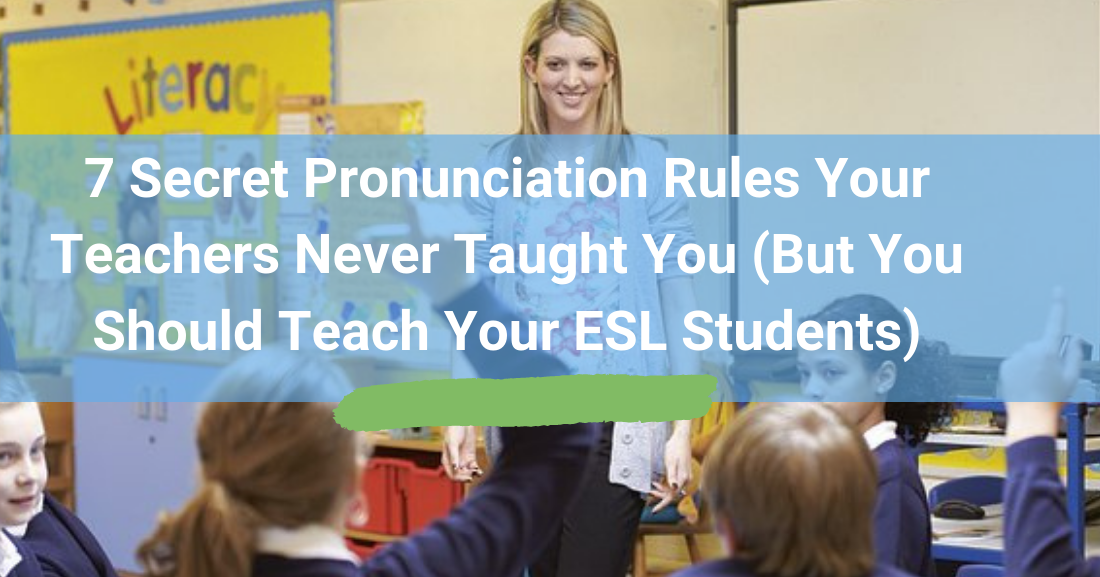English spelling is at best confusing and at worst a hot mess.
It is no wonder so many ESL students struggle with making the connection between written words in English and how they are pronounced. Sometimes there doesn’t seem to be any rhyme or reason to it. I am a big proponent of teaching the phonetic alphabet to ESL students, primarily because I think it makes a big difference in their ability to achieve accurate pronunciation. But sometimes the phonetic alphabet is not an option.
You might have ESL students who are casually studying the language and do not want to cover any material so academic. You might opt out of teaching the phonetic alphabet because you just have too many other things to do. Or it might be some other reason. After all, how many dictionaries use the phonetic alphabet when listing the pronunciation for an entry? Whatever your reason for not using the phonetic alphabet, there is good news. As unpredictable as English spelling and pronunciation may seem at times, there are some rules that your students can follow when they encounter unfamiliar words. Here are seven simple spelling and pronunciation connections you can share with your students to help them achieve accurate pronunciation.

Remember Rules for Pronouncing Vowels
-
Before going through these rules with your students, they will need to know the difference between short vowel sounds and long vowel sounds. If you are unclear about these definitions, look for an explanation in a standard English only dictionary or read about it here.
-
1
A Vowel Followed by a Single Consonant at the End of a Word Is Pronounced as a Short Vowel
Words that conform to this rule are often some of the first that students of English (as well as native speakers) learn to read. Pup has cup. Man has ham. All of these words follow the short vowel + consonant rule. You might see these words represented in this way. CVC.
-
2
A Vowel Followed by Two Consonants at the End of a Word Is Pronounced as a Short Vowel
Words that conform to this rule may be single vowels followed by a consonant blend (see below for an explanation of consonant blends) or those that are followed by two distinct consonants. You may see these types of words represented in this way. CVCC. Some examples include the following:
• Stops
• Want
• Hand
• Wish
• Bark -
3
If a Vowel Is the Final Letter in a Word, It Is Pronounced as a Long Vowel
A vowel at the end of a word may appear in a single syllable word or a multisyllabic word. Either way, the pronunciation rule remains the same. A final vowel at the end of a word is pronounced as a long vowel. Some examples of single syllable words which follow this rule are go, pi, lo, be, and he. Multiple syllable examples include ago and ego. You might see these words represented like this CV.

-
4
If an E Appears at the End of a Word, It Is Silent. The Preceding Vowel (Separated from the E by One or More Consonants) Will Be Pronounced as a Long Vowel
Silent e is one of the first spelling rules children learn in school, and no wonder since it is so common in English. If you are teaching phonics, you might have students underline or cross out the silent e and mark the preceding vowel as long. You might see words which follow this rule represented in this way: CVCe. You can find examples throughout the English language, but some of them are hate, care, note, flute, bite, nice, and ape.
-
5
If Two Vowels Appear next to Each Other in One Syllable, the Second Vowel Is Silent and the First Vowel Is Pronounced as a Long Vowel
We see vowel combinations all the time in English. A general rule as to their pronunciation is to say the first vowel and ignore the second. These vowel combinations come in all kinds of match ups. You might see words which follow this rule represented this way: CVVC. English examples include true, beat, train, leaf, and load.

Consider Rules for Pronouncing Consonants
-
One thing to keep in mind when discussing consonant pronunciation are consonant blends. A consonant blend is two or more letters that are pronounced as one sound in English. Some blends are clearly two sounds which become one complex sound (for example bl in black, tr as in atrophy). They often include the letters l, r, or s but not always. Other “blends” are actually only one English sound which is spelled by using two or more consonants. These sounds include sh (wish), ch (chair), tch (watch) and others.
-
6
If One Consonant Follows a Vowel in the Middle of a Word, It Is Pronounced as the First Sound in the Next Syllable
Where a consonant is pronounced in a word does make a difference in a student’s pronunciation, particularly if they speak slowly. Think about the difference between pap-er and pa-per. Clearly the second is the correct pronunciation while the first sounds, at best, strange, and at worst like a different word entirely. Other examples include tele-phone (not teleph-one), la-bor (not lab-or), lo-cate (not loc-ate) and pro-tect (not prot-ect).
-
7
When Two Consonants Follow a Vowel in the Middle of a Word, One Consonant Is Pronounced at the End of the First Syllable and the Other Is Pronounced at the Beginning of the Next Vowel
Of course, consonant blends act as one consonant sound, but non-blend neighboring consonants will follow this rule. When a consonant is doubled in the middle of a word, it also follows this rule. Some examples include sub-ject, tal-ly, ab-ject, top-ple, and haz-mat.
Ultimately, English is a complicated language with complicated rules of spelling and pronunciation. These rules, while generally true, do have exceptions. When you teach them to your students, be sure that they know these rules are not hard and fast and that exceptions can be found to each of them. They may choose to use these rules to pronounce words they have never seen before, or they may use the rules to determine the spelling of an unfamiliar word they have heard pronounced. What matters most, however, is that these rules give your students a place to start when they encounter a word that they do not know how to pronounce.
What other pronunciation rules do you teach your ESL students?
P.S. If you enjoyed this article, please help spread it by clicking one of those sharing buttons below. And if you are interested in more, you should follow our Facebook page where we share more about creative, non-boring ways to teach English.







